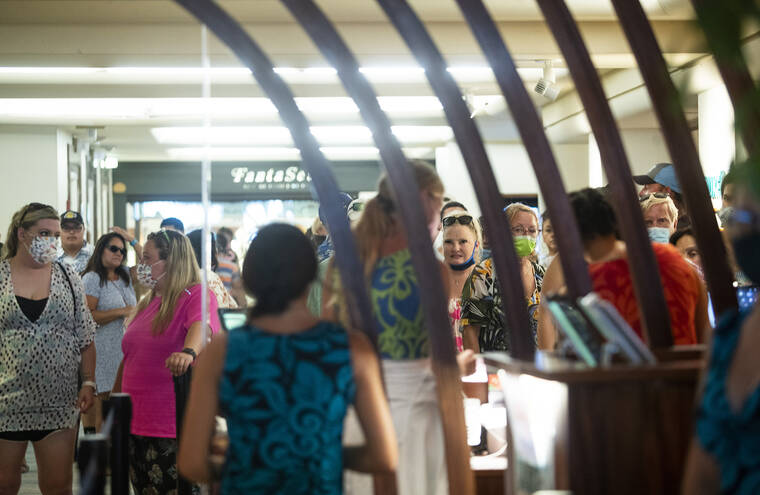Some key county-level pandemic rules are nearing their end, yet Hawaii remains a national outlier on one major statewide restriction: the indoor mask mandate.
Maui County Mayor Mike Victorino announced Friday that proof of vaccination against COVID-19 or negative test results will no longer be required next week for indoor service at establishments such as restaurants, bars and gyms.
On Oahu, Mayor Rick Blangiardi appears ready to let the city’s Safe Access O‘ahu program, with similar restrictions for indoor venues, expire March 6, the end date he set when he implemented the restriction Jan. 5.
But this week Hawaii also became the only state in the nation that has not either lifted or announced plans to lift its mask mandate.
The distinction came after the governors of New Mexico and Washington on Thursday announced plans to drop their states’ mandates.
In a written statement, Hawaii Gov. David Ige said, “I am working with the Department of Health to determine when the time is right for Hawaii to lift the indoor mask mandate. Hawaii ranks second in the nation when it comes to COVID deaths, in part because of the indoor mask requirement and other measures that have proven successful in protecting our community from this potentially deadly virus. Our decisions are based on science, with the health and safety of our community as our top priority.”
Ige’s wait-and-see approach has its supporters in the islands.
Hilton Raethel, president and CEO of the Healthcare Association of Hawaii, said Ige’s relatively cautious and strict measures to stave off COVID-19 have contributed to Hawaii’s low transmission and death rates.
“That’s something to be very proud of, and that didn’t happen by accident. It happened because of a number of initiatives and public health measures, including the mask mandates,” Raethel said.
Hawaii was ranked by WalletHub Opens in a new tab as the safest state to live in during the pandemic, placing the state in the top five when it comes to COVID-19 transmission rates and death rates from the virus. Statista ranked Opens in a new tab Hawaii as having the lowest death rate in the country, with 89 deaths per 100,000 people.
Lt. Gov. Josh Green told the Honolulu Star-Advertiser in a text, “Our strong public health approach saved more than 10,000 lives over the past two years, particularly among our kupuna.”
And Hawaii’s omicron surge continues to wane.
Hawaii recorded 485 new coronavirus cases and two virus deaths Friday. At the height of the state’s omicron surge in mid-January, Hawaii peaked with 6,252 daily cases. The number of hospitalized coronavirus patients statewide fell to 121 Friday, down 70% from its omicron peak of 400 on Jan. 24.
Tina Yamaki, president of the Retail Merchants of Hawaii, said it’s unclear how shoppers and employees will react once the state’s indoor mask mandate for public places is lifted.
“It’s going to be (dependent) on the comfort level of the customers and the employees,” Yamaki said. “That’s the unknown. We probably will lose some employees over it, and they’re hard to find right now. We may gain some customers if they don’t have to wear masks anymore … or we may lose some customers if they don’t feel safe going out anymore, because the pandemic isn’t over yet.”
Even though COVID-19 cases are waning, Yamaki said, the end of the pandemic has been within reach several times before, only to be met with a spike in cases or new problem variants such as delta and omicron.
“The last couple of times this happened, the light at the end of the tunnel was a train — it wasn’t a light,” she said. “Is this really the end, or is there going to be another train coming?”
Raethel said the worst-case scenario is having another “wild variant” of COVID-19 flip the state’s trajectory, but the local population is more protected against that now than at any other point during the pandemic.
Hawaii’s population is 75.7% fully vaccinated, and 36.8% have received a booster shot, according to state Health Department statistics.
The state mask mandate will probably be eliminated in March or April, Raethel said, although he anticipates that people will choose to wear masks afterward.
He said that despite the opposition to some of the state and county restrictions, the overall compliance suggests that people in Hawaii understand why they are in place.
Raethel said it also demonstrates Hawaii’s sense of community.
“For us to be the last state in the nation to drop a mask mandate, that’s something that we can be proud of,” he said. “We have been protecting ourselves; we have been protecting our communities, our families, our co-workers. Many people would consider that to be a badge of honor.”
While Ige continues to review state-level mandates, Hawaii’s mayors are looking forward to eliminating county-level restrictions.
On Maui, Victorino said he was dropping the vaccination-or-testing requirements for indoor establish- ments effective Monday.
“With the rapid decline of new COVID-19 cases and related hospitalizations, we can safely eliminate the proof-of-vaccination requirement for bars, restaurants and gyms,” Victorino said in a statement.
“We successfully avoided overloading our health-care capacity, so many thanks to the community and especially the business operators who have struggled through this entire pandemic. Mahalo for your cooperation,” he said.
And on Oahu, Blangiardi signaled that he was not going to extend the Safe Access O‘ahu program past its March expiration date. He told Hawaii News Now on Thursday that he was “very close” to making the final decision to no longer require employees and customers to be vaccinated or test negative for COVID-19 at businesses such as restaurants, bars, gyms and movie theaters.
Blangiardi’s office did not respond to multiple Star- Advertiser requests for comment about that pending decision.

